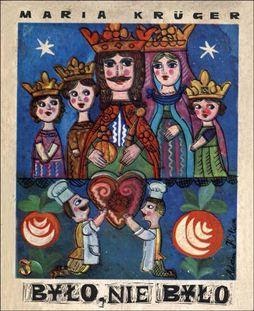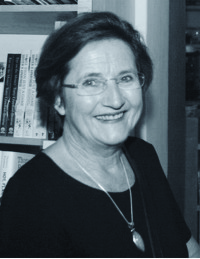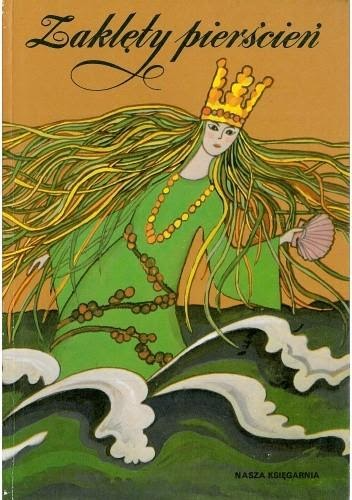Title of the work
Country of the First Edition
Country/countries of popularity
Original Language
First Edition Date
First Edition Details
Maria Krüger, "O szlachetnym Gryfie i pięknej Syrenie” in Było, nie było [Whether True or Not], Warszawa: Nasza Księgarnia, 1966, 61, [3] pp., 28–32.
ISBN
Genre
Legends
Target Audience
Children (crossover)
Cover

Courtesy of the publisher.
Author of the Entry:
Summary: Ewa Wziętek, University of Warsaw, ewawzietek@student.uw.edu.pl
Analysis: Marta Pszczolińska, University of Warsaw, m.pszczolinska@al.uw.edu.pl
Peer-reviewer of the Entry:
Katarzyna Marciniak, University of Warsaw, kamar@al.uw.edu.pl
Elżbieta Olechowska, University of Warsaw, elzbieta.olechowska@gmail.com

Retrieved from Narodowe Archiwum Cyfrowe (accessed: December 17, 2021).
Adam Kilian
, 1923 - 2016
(Illustrator)
Adam Kilian was an eminent Polish scenographer, graphic designer and illustrator. He was originally from Lwów; during WW2, he and his family were deported to Samarkand. There, his mother founded Teatr Lalek Niebieskie Migdały [Puppet Theatre of Dreams]. In 1944, he enrolled at the Faculty of Architecture of the College of Arts and Crafts in Nottingham. After graduation, he came to Poland and devoted himself to theatrical scenography, co-creating many performances – children’s spectacles and puppet shows and operas and repertory theatre. At first, he worked for his mother’s Niebieskie Migdały Theatre in Warsaw, then in Teatr Lalka [Theatre “Puppet”] where during a 60-year artistic career, he created many performances inspired by folklore, folk art and/or naïve art.
He also frequently worked for adult audiences at Teatr Współczesny [Modern Theatre] in Szczecin, Teatr Powszechny [Theatre for All], Teatr Narodowy [National Theatre] and Teatr Polski [Polish Theatre] in Warsaw or Teatr im. J. Słowackiego [J. Słowacki Theatre] in Kraków. In total, he created 323 scenographies for theatres in Poland and abroad. He also designed scenographies for 22 television plays, as well as 72 cartoons and animated puppet films. He illustrated many children’s books and cooperated with Płomyczek [Flicker], a popular weekly magazine for children. In addition, he designed posters and postcards.
He received many awards for his contributions to Polish culture (see the list of his awards at culture.pl), including his favourite, Order Uśmiechu (The Order of the Smile), the international award granted by children to adults for bringing them joy.
Sources:
Adam Kilian at culture.pl (accessed: November 25, 2021);
Adam Kilian at filmpolski.pl (accessed: November 25, 2021);
Adam Kilian at encyklopediateatru.pl (accessed: November 25, 2021).
Bio prepared by Marta Pszczolińska, University of Warsaw, m.pszczolinska@al.uw.edu.pl

Photograph retrieved from Encyklopedia Fantastyki (accessed: December 28, 2020).
Maria Krüger
, 1904 - 1999
(Author)
A writer, journalist, economist. Graduated from the Faculty of the Humanities at the University of Warsaw; alumna of the Academy of Political Science in Warsaw. During WW2, she participated in the Warsaw Uprising (1944). She began publishing for children and teenagers in children’s periodicals such as “Płomyczek,” “Dziatwa,” “Słonko,” “Świerszczyk,” “Płomyk.” She proposed the idea and wrote texts for the television show Miś z okienka [Teddy Bear at the Window]. Her books have been translated into foreign languages and adapted for films. She is best known for her novel Karolcia [Charlotte], 1959.
Sources:
"Maria Krüger", in Elżbieta Zarych, ed., Słownik pisarzy polskich, Kraków: Krakowskie Wydawnictwo Naukowe, 2008, 253.
"Maria Krüger", in Jadwiga Czachowska and Alicja Szałagan, eds., Współcześni polscy pisarze i badacze literatury. Słownik biobibliograficzny, vol. 4: K, Warszawa: Wydawnictwa Szkolne i Pedagogiczne, 1996, 387–389.
"Maria Krüger", in Lesław M. Bartelski, Polscy pisarze współcześni 1939–1991. Leksykon, Warszawa: Wydawnictwo Naukowe PWN, 1995, 207.
Maria Krüger, wikipedia.org (accessed: December 28, 2020).
Maria Krüger, encyklopediafantastyki.pl (accessed: December 28, 2020).
Bio prepared by Gabriela Rogowska, University of Warsaw, g.rogowska@al.uw.edu.pl
Summary
Based on: Katarzyna Marciniak, Elżbieta Olechowska, Joanna Kłos, Michał Kucharski (eds.), Polish Literature for Children & Young Adults Inspired by Classical Antiquity: A Catalogue, Faculty of “Artes Liberales”, Warsaw: University of Warsaw, 2013, 444 pp.,
Many years ago, when Warsaw was still a small town, a strange creature lived there: a lion with a young man’s face, a snake’s tail and bat wings, called Griffin. He lived among fishermen and raftsmen and was very fond of the city of Warsaw. He was the most powerful and fair protector of the city. One day, he set out on a journey to the Baltic Sea. On the way, he admired the Polish landscapes and enjoyed the journey very much. He did not even notice when the boat had reached Gdańsk. As he came near the seashore, a beautiful Mermaid emerged from the sea. She was singing a song so beautiful that Griffin was unable to leave her. They fell in love and went together to Warsaw. They lived a peaceful and happy life until the war between Poland and Sweden. Griffin fought bravely but died of wounds. The lovely Mermaid did not waste any time, picked up Griffin’s sword and fought as bravely as her lover did. Finally, the Swedish warriors gave up fighting and returned to Sweden. And since then, inhabitants of Warsaw began using the image of the Mermaid as their municipal seal (now the Mermaid is the symbol of the city of Warsaw and figures on its coat of arms).
Analysis
This story about two mythical creatures being a part of the Slavic bestiary is based on oral tradition. Though the tale refers to the legendary origins of Warsaw and belongs to Polish folklore, it also refers to Classical Antiquity at two levels – linguistic and semantic.
First, both mythical characters use their ancient names. Though they are not exact equivalents of the ancient creatures, their Polish names are calques of Greek words – Gryf for γρύψ, and Syrena for Σειρήν. The Polish gryf is here described as having a winged lion’s body similarly to γρῦπες presented by Aelian in On Animals (4.27*), but its wings are featherless like the wings of a bat, and its face is entirely human. As the Polish language does not differentiate between sirens and mermaids, these mythical creatures have the same name, syrena. The syrena is a hybrid creature in the legend, but unlike her ancient version and her medieval or even 17th-century image on the Warsaw crest, she is a mermaid. It is worth noting that the time of the Swedish occupation of Warsaw (1655-56), when according to the legend, the griffin died, corresponds approximately to when the Syrena on the Warsaw crest began to be presented as a mermaid and not a siren (accessed: December 17, 2021).
Second, the connection with the ancient world derives from the significance of the two characters. Both are described as noble, upstanding, fair and beautiful, which reflects their qualities. Gryffin is endowed with a handsome human face which emphasizes his humanity and highlights his noble personality. Though his hybrid lion-snake-bat body is animal in nature, his superior mind, brave and honourable character, fortitude and empathy make him a model of multiple virtues. Similarly to the ancient sources (Herodotus, Aelian, Philostratus or Plinius) where the γρῦπες (griffins) are told to be mythical guardians of gold, Gryf is here depicted as a guardian. His precious treasures are the town and its inhabitants, and he protects them from fire, flood, storms and assaults. Even when the griffin begins his relationship with the mermaid, he does not abandon his interest in protecting the people of Warsaw. On the contrary, the town gains an additional ally and – after griffin dies trying to rescue the town, a new protector, the Syrena, defends Warsaw with her sword. The Syrena, a daughter of the king of the Baltic Sea, is another ancient character. Though she is a mermaid, i.e., a woman-fish hybrid, she has an enchanting singing voice like ancient sirens. She tries to convince Gryf to stay with her forever so she can sing him his favourite melodies, but when he refuses, she leaves the sea and moves to Warsaw. The couple symbolizes the noble duty to protect civilians.
* Aelian, De natura animalium, 4.27:
τὸν γρῦπα ἀκούω τὸ ζῷον τὸ Ἰνδικὸν τετράπουν εἶναι κατὰ τοὺς λέοντας, καὶ ἔχειν ὄνυχας καρτεροὺς ὡς ὅτι μάλιστα, καὶ τούτους μέντοι τοῖς τῶν λεόντων παραπλησίους: κατάπτερον δὲ εἶναι…
I have heard that the Indian animal the Gryphon is a quadruped like a lion; that it has claws of enormous strength and that they resemble those of a lion. Men commonly report that it is winged… (trans. by A. F. Scholfield).
Further Reading
Miller, Przemysław, Historia herbu, http://www.um.warszawa.pl/owarszawie/kompendium-wiedzy/historia-herbu?page=0,1 (accessed 14.02.2012, no longer available).
Monte, Richard, The Mermaid of Warsaw and Other Tales from Poland, London: Frances Lincoln Limited, 2011 (accessed via Google Books, 21.03.2013).
"Gryfy", "Syreny", in Stanisław Stabryła, Słownik szkolny. Mitologia grecka i rzymska, Warszawa: Wydawnictwa Szkolne i Pedagogiczne, 1994, 90, 195–196.
Warsaw Legends, http://warsawtour.pl/en/warsaw-for-everyone/for-kids/warsaw-legends-3160.html?page=0,0 (accessed 21.03.2013, no longer available).
Addenda
The legend was included in a collection of Polish folkloric fairy tales, stories and legends Zaklęty pierścień [The Enchanted Ring], edited by Maria Kochanowska, published by Nasza Księgarnia in 1982.

Courtesy of Nasza Księgarnia.


